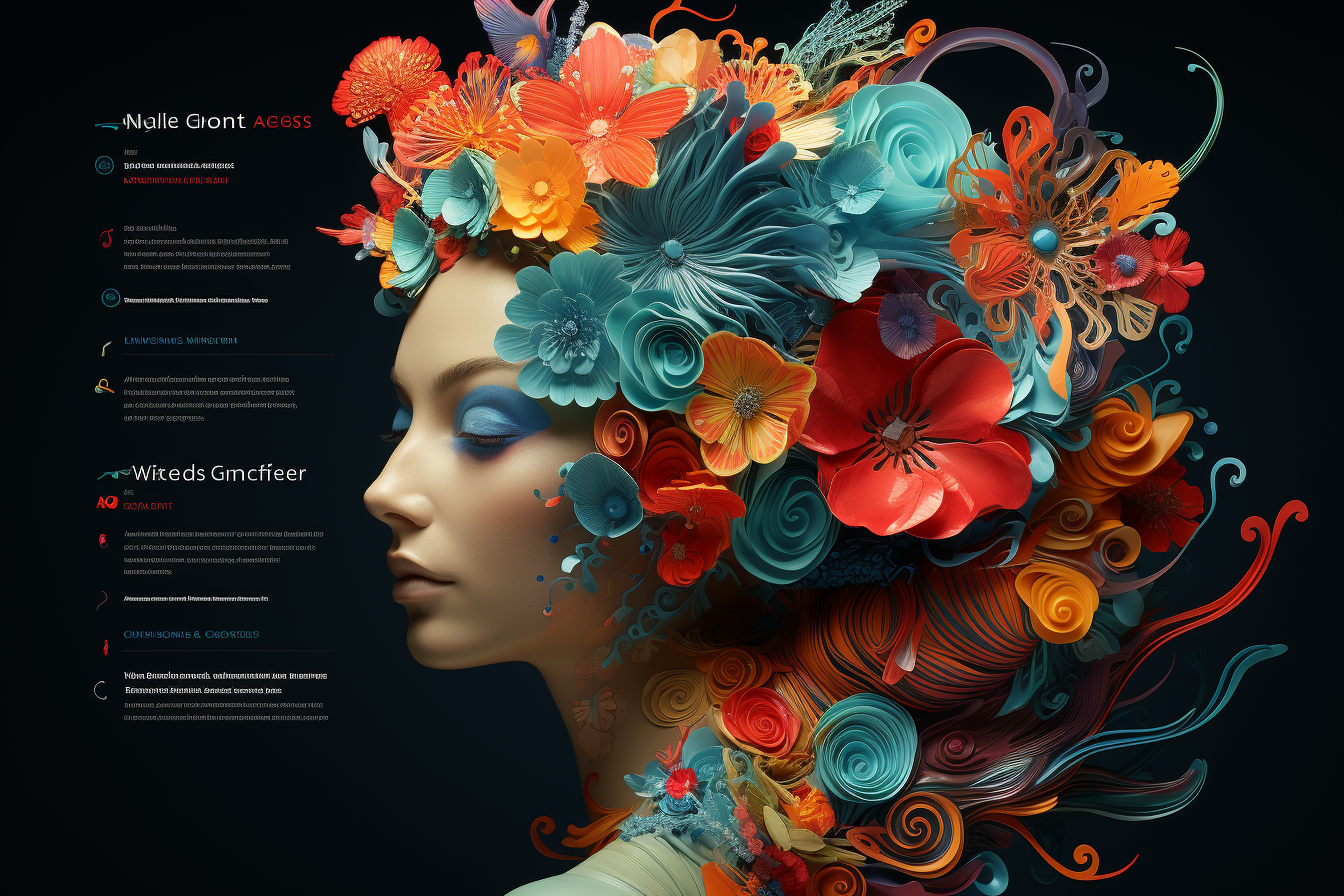Getting Started with Adapting to New Design Styles
Design trends are constantly changing, and it is critical for a designer to stay current with the latest design styles. Adapting to new design styles can be difficult, but it is essential for designers to stay current in the market. Whether you work as a graphic designer, web designer, or UX designer, you must stay current with design trends and adjust your style accordingly. We will explore nine concepts of adjusting to new design trends in this blog post.
Keep Up With The Latest Design Trends.
Follow design trends to adapt to new design styles. As a designer, you must stay current on design trends, approaches, and technology. To accomplish this, attend design conferences, read design blogs, and join online design organizations. These tools can help you learn about the newest design trends and adjust your style.
Participate in the design community. To stay current, designers, design blogs, and design journals should be followed on social media. Participate in design groups, design challenges, and design conferences to network with other designers and learn about new trends.
Experiment with new design techniques. Experiment with various design software, styles, and trends to see what works best for you. Experiment with new things and get out of your comfort zone.

Get ideas from a variety of sources. Look for inspiration in various sectors, civilizations, and art movements. Visit art galleries, museums, and exhibitions to learn about design styles and techniques.
Maintain your technological knowledge. With the advancement of technology, new design patterns develop. Keep up with emerging technology, such as virtual and augmented reality, to see how you might incorporate it into your ideas.
Not all design trends apply to your work or clients. Maintain your design style and your client’s brand identification while introducing acceptable current trends. Staying current with design trends requires being linked to the design community, experimenting with new methods and tools, getting inspiration from diverse sources, and monitoring technical advances. By following design trends, designers may create original, relevant designs that meet client needs and stay competitive.
Recognize The Design’s Purpose
Every design serves a function, whether to inform, convince, or entertain. As a designer, you must grasp the design’s objective as well as the intended audience. This knowledge can assist you in adapting your style to better suit the needs of the audience and the aim of the design.

Understanding the target audience is the first step in recognizing the design’s purpose. Who is the design meant for, and what are their wants and preferences? Understanding the target audience is critical for producing designs that speak to them and suit their demands.
Consider the context in which the design will be utilized next. What is the context in which the design will be seen or used? Is it a digital platform, print media, or physical space? Understanding the context of the design is critical for generating designs that are appropriate and effective in their intended location.
Finally, think about the design’s goals and objectives. What is the intended outcome of the design, and how will its success be measured? Understanding the design’s goals and objectives is critical to generating designs that are successful and accomplish the desired results.
Maintain An Open Mind
New design styles require an open mind. Designers may stay competitive by being open to new ideas and methods. New design methods must be approached with curiosity and openness. Open your thoughts by seeking inspiration from other sources. Find inspiration in other cultures, industries, and aesthetics. Visit museums, galleries, and exhibitions to learn about design styles and methods. Open your mind by working with various designers. Join design groups, forums, and challenges, and get input from other designers. Working with other designers may inspire new ideas and insights.

Openness to new design styles is essential. By collaborating and getting inspiration from various sources, designers can be open to new ideas and techniques.
Examining The Competition
Examining the competition is an important component of adjusting to new design styles. As a designer, you may have a preferred style, but the design profession is continuously growing, and it is critical to keep up with the current trends and approaches.
You can obtain useful insights into the latest design trends and methodologies by evaluating the work of other designers in your area. Examining the competition might assist you in identifying market gaps and possibilities to differentiate your designs. You can learn from their accomplishments as well as their failures.

Begin by studying and assessing the leading designers in your field. Examine their designs for similar themes and trends, and determine the qualities that make their designs successful. Take note of how they employ color, font, imagery, and layout to create aesthetically appealing designs.
Researching the competition is an important aspect of adjusting to new design styles. You can obtain useful insights into the latest design trends and methodologies by evaluating the work of other designers in your area. This data can assist you in identifying possibilities to differentiate your designs and develop unique ideas that match the needs of your clients and audience.
Accepting Flexibility
Embracing flexibility is one of the most crucial elements of adjusting to changing design styles. You must be willing to attempt new things and experiment with different styles and techniques as a designer. Being open to change and adapting to new trends and design styles is what flexibility entails.

Being adaptable allows you to broaden your skill set and stay current in the ever-changing design business. This implies you must be willing to explore with new design styles, processes, and tools outside of your comfort zone.
Begin by broadening your knowledge of design trends and methodologies to embrace flexibility. To learn about the newest design trends and techniques, attend design conferences, read design blogs and publications, and take online courses.
Start experimenting with the newest design trends and approaches in your own work after you have a deeper understanding of them. Experiment with new color palettes, alternate text styles, and layout designs. Use other designers’ techniques as inspiration and adapt them into your own work.
It is equally critical to be open to receiving feedback and criticism on your work. You can learn from your mistakes and improve your design skills by being open to feedback. Don’t be afraid to solicit criticism from fellow designers, clients, and even your target audience. This input can assist you in identifying places where you can improve your designs and more successfully adapt to changing styles.
Understanding User Requirements
Design is about more than just making visually appealing designs; it is also about addressing the demands of the user. Understanding the demands of the user is a critical aspect in adjusting to new design trends. It is critical for a designer to understand the target audience and their preferences. It is critical to consider user experience (UX) and user interface (UI) design concepts when adjusting to new design styles. These principles help ensure that your designs are user-friendly and easy to use and navigate.
Begin by performing research on the intended audience to better understand their needs and preferences. Analyze user data and comments to find common pain spots and areas where the user experience can be improved.
Consider the user’s journey and how they will engage with the design while building a new design. This includes comprehending the context in which the user will interact with the design, such as the device and environment in which they will use it.
Understanding user wants is an important element in adjusting to new design trends. You may create designs that match the needs of the user and deliver a positive user experience by performing research on the target population and following UX and UI design principles. Consider the user’s path and how they will engage with the design, and make sure that all users can access your designs. You may build designs that are not only visually beautiful but also deliver value to the user by taking user demands into account.
Keeping Consistency
Another crucial concept of adjusting to new design trends is consistency. Consistency is critical for developing a unified and memorable brand identity. It assists people in recognizing and remembering your brand, as well as building trust and familiarity with your target demographic.
It is critical to maintain consistency across all design aspects, including color, typography, layout, and images when adapting to new design trends. This ensures that your brand remains identifiable and consistent, even when new design styles are used.
Begin by creating brand standards that explain your brand’s major design aspects, such as color palettes, typography, and logo usage. All design aspects, including the website, social media, and marketing materials, should adhere to these criteria consistently.
It is critical to incorporate these standards into new designs while adjusting to new design styles. This can be accomplished by using color palettes, typography, and imagery that are consistent with the brand guidelines.
Consistency is critical for developing a unified and memorable brand identity. You can maintain consistency across all design elements by setting brand guidelines and using consistent design elements and UX design principles. When implementing new design styles, make sure they complement the overall brand identity and maintain consistency in content development. Maintaining consistency allows you to generate trust and familiarity with your audience while also developing a strong and recognizable brand identity.
Accepting Innovation
Another crucial element of adjusting to new design patterns is to embrace innovation. Staying current in an ever-changing design landscape and pushing the frontiers of design require innovation. It is critical to keep up with the newest design trends and technologies when adjusting to new design styles. Attending design conferences, following design blogs and magazines, and networking with other designers can all help.
Experimenting with new design processes and technology can also lead to innovation. This can include experimenting with new software tools, trying out new design methods, or pushing the limits of established design styles. It is critical to approach innovation with a mix of creativity and pragmatism. While it is crucial to experiment with new design processes and technology, it is equally critical to ensure that they connect with the client’s or project’s needs and goals.
Collaboration with other designers and creatives can also lead to innovation. Working with designers from other backgrounds and disciplines to explore new ideas and approaches can be part of this.
When embracing innovation, keep in mind that not all new design styles and methodologies will b Embracing innovation is critical for remaining relevant in the ever-changing design landscape and pushing design boundaries. Staying current with design trends and technologies, experimenting with new design processes and technologies, and collaborating with other designers and creatives can all be part of this. When embracing innovation, it is critical to strike a balance between creativity and pragmatism, and to analyze each new design style or technique on an individual basis. You may build designs that stand out and push the boundaries of design by embracing innovation.
Responding To User Feedback
User feedback is critical for developing designs that are easy to use, intuitive, and effective. It assists designers in understanding the wants and preferences of the target audience and making design improvements accordingly. It is critical to get user feedback early and frequently while transitioning to new design trends. User testing, surveys, and feedback forms can all be used to accomplish this. The responses should be examined and used to guide design decisions.
Responding to user feedback is critical for developing designs that are user-friendly, intuitive, and effective. Designers may build designs that fit the goals and preferences of the target audience by obtaining input early and frequently, making revisions depending on the feedback, and remaining up to speed with the latest design research and best practices. When responding to user feedback, prioritize the comments that will have the biggest influence on the user experience, ensuring that the changes correspond with the overall design goals and brand identity, and treat feedback with a growth mentality.








